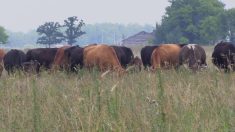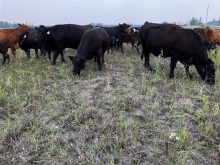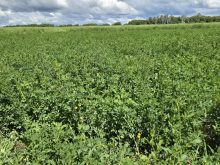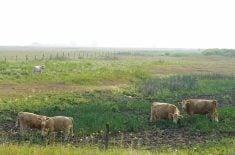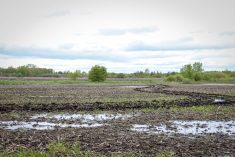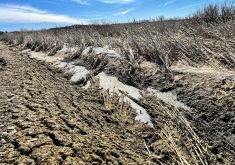Crop insurance figures keep getting bigger.
The 2021 group season will generate around $650 million in payouts due to low yields during the drought.
And the resulting higher prices will mean that is followed by a record $4.66 billion in crop insurance coverage for the 2022 growing season.
That $4.66 billion in coverage is based on farmers insuring crops on 9.8 million acres of land, Manitoba Agriculture Minister Derek Johnson told the Keystone Agricultural Producers (KAP) in a pre-recorded video during KAP’s online annual meeting Jan. 25.
Crop insurance coverage for 2022 is expected to average a record $463 an acre, compared to $321 in 2021. That’s a 44 per cent increase. (See all insured dollar values for 2022 at the MASC website here)
Read Also

Seeding Indigenous agricultural prosperity
National Circle for Indigenous Agriculture and Food says Indigenous agricultural success needs strong relationships.
Crop insurance (AgriInsurance), is a federal-provincial program designed to be actuarially sound over time.
Farmers trigger a crop insurance payment when production falls below their insured yield, which is based on historical production.
Payouts are calculated by multiplying the number of bushels per acre the farmer is short by the dollar value crop insurance assigns to the crop in January before the crop is seeded.
Why it matters: Record crop insurance coverage follows a record payout year for insured Manitoba farmers, many of whom see the program as their main hedge against production risk.
The 2022 dollar value assigned to canola should a farmer’s insured yield fall below their coverage is $15.88 a bushel, up 41 per cent from last year’s $11.83.
In September Homewood farmer Warren McCutcheon flagged the need for crop insurance to set its 2022 dollar values to better reflect market prices, which took off after harvest.

“I felt all the numbers were fair and kind of what we were expecting,” McCutcheon said in an interview Jan. 26, after having reviewed them. “That 30 to 40 per cent bump or more in commodity prices has been pretty consistent for a year and it’s reflected in that a little bit now.”
This year’s dollar values are in line if one looks at prices since harvest relative to new-crop bids, he added.
“These dollar values, we believe, represent the entire crop year for 2022-23… not just what you can contract today,” David Van Deynze, chief product officer with the Manitoba Agricultural Services Corporation (MASC), which administers the federal-provincial AgriInsurance program in Manitoba, said in an interview Jan. 25. “That’s what we are trying to reflect here.”
With farmers’ production costs skyrocketing they need higher crop insurance coverage to mitigate their risk, McCutcheon said.
While higher insurance coverage means higher insurance costs per acre, he expects most farmers will opt for the highest coverage — 80 per cent of their long-term average yield. Farmers have the option to take less coverage and pay less, he added.
Farmers prefer harvesting a good crop and hope they never need crop insurance, McCutcheon said.
“That really is our only tool to mitigate that risk,” he said.
Challenging
Trying to predict crop prices farmers will get at least six months before they even plant is difficult, but necessary so farmers know what they are before they sign insurance contracts before the March 31 deadline, Van Deynze said.
MASC relies on Agriculture and Agri-Food Canada’s price forecast to set dollar values for insured crops.
In addition, to the cost of insuring crops on a per-acre basis rising to reflect higher coverage, there will be a 10 per cent increase in the premium rate to help replenish crop insurance reserves cut almost in half due to the 2021 drought.
“By the time 2021 is done we think there will be about $410 million in the surplus, which is almost $400 million less than it was,” Van Deynze said. “It too took a pretty good hit.”
Since there’s a two-year lag in the 10-year yield averages used to help set crop insurance premiums, 2021 yields won’t come into play until 2023, he said.
“There are a couple of pieces that go into our premium calculation,” Van Deynze said. “One is the overall program fund balance and we are including the impacts of 2021 for the fund balance immediately so it’s part of the calculation for 2022. But the individual crop’s success or failure in 2021 won’t be part of the premium calculation until 2023’s program year. Premiums are up 10 per cent in 2022. Unless we have something to offset it between now and then we expect premiums will be up some in 2023 as well on a per-crop basis. How much yet is way too early to tell, but just given that yields were down generally (in 2021), and payouts on a per-crop basis were significant, we expect that will happen.”
The $4.66 billion in coverage assumes Manitoba farmers will seed as many acres of most crops as they did last year. Plantings of the three top acreage crops — canola, red spring wheat and soybeans — fluctuate, but have remained in that order for years.
“I think there’s no doubt it’s going to be a record,” Van Deynze said.
“We’re really confident with that. I don’t think there’s a crop mix out there that would result in a lower number just because all the dollar values are up significantly at this point.
“These are insured values we’ve never seen before and canola is one of them.”

With many claims yet to settle, MASC estimates it will pay out around $650 million to cover crop losses in 2021, he said.
“That’s huge,” Van Deynze said. “It’s probably almost double anything we have paid before.”
If the estimates are accurate the total 2021 payout will be double the next-biggest payout of $325 million in 2011, he said.
“That year almost a third of the province didn’t get seeded because of excess moisture and then what did get seeded largely suffered after that,” Van Deynze said.
But the dollars paid out from crop insurance don’t tell the whole story given the increase in insured crops and inflation.
“In the insurance world we measure it as a percentage of coverage because our program has grown so much,” he said.
“So we’re looking at paying out about 20 per cent of our coverage, which is significant, but certainly we’ve had worse years than that — a worse year in 1988 and a worse year in 2005… from a percentage of coverage perspective, but this would be our worst payout year purely from a dollars perspective.”
Most crop insurance payments in 2005 were the result of excess moisture. In 1988 it was drought.
Based on industry and farmer feedback, several changes will be made to crop insurance in 2022, Johnson told KAP.
New polycrop establishment insurance will provide financial aid to Manitoba farmers if an eligible polycrop fails to establish.
Polycrops are a mixture of two or more annual crops, other than greenfeed, grown simultaneously on the same acreage for livestock feed, soil restoration or green manure.
An increase in the indemnity level for table and processing potatoes destroyed before harvest from 85 per cent to 90 per cent, will better reflect potato-harvesting costs.
Updated vegetable acreage loss insurance reduces the minimum acres for the program to one-half from three, helping smaller commercial producers.
MASC hopes to have confirmation of crop insurance documents delivered to Manitoba farmers early this month.
“They should look at their confirmation closely,” Van Deynze said. “With big changes in dollar values they need to make sure they are comfortable with the coverages they have signed up for.
“The higher dollar value itself doesn’t change what we call the ‘rate.’ Premiums per acre are changing for sure, but I hope when people see that premium per acre… I hope they look at the next column that shows how much more coverage they are having (per acre) too.”
If they need to make some changes they need to do that before March 31.”




